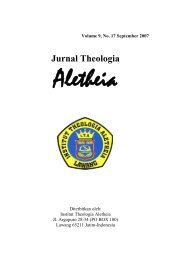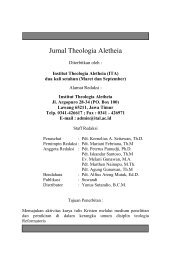download - Sekolah Tinggi Theologia Aletheia Lawang
download - Sekolah Tinggi Theologia Aletheia Lawang
download - Sekolah Tinggi Theologia Aletheia Lawang
Create successful ePaper yourself
Turn your PDF publications into a flip-book with our unique Google optimized e-Paper software.
92<br />
lawyer in Mark 12.28-31||Matt 22.34-40. 115 Calling the parable an<br />
example story 116 certainly helps to bolster these two arguments as<br />
it generalises the applicability of the parable. Nevertheless, there<br />
are good grounds for assuming that the frame of the parable is<br />
authentic and has always been joined with the parable.<br />
First of all, the arguments usually cited cannot stand up to<br />
scrutiny. Indeed, the argument that Luke tends to generalise is a<br />
generalisation in itself. Why should it be thought that if Luke<br />
generalised the parable of the persistent widow in Luke 18, he was<br />
certainly doing the same with the parable of the Good Samaritan?<br />
Furthermore, the perceived similarities between Mark 12.28-31 and<br />
Luke 10.25-37 have been overdone. It must be pointed out first of<br />
all that the alleged parallel does not contain a parable and for the<br />
objection to stand, it must be presupposed that Luke first found the<br />
parable without a frame and used the alleged parallel as the basis<br />
for the composition of the frame. Postulating that Luke expunged<br />
an original frame and replaced it by that which required<br />
composition from an alleged parallel stretches belief. Moreover, in<br />
the former passage, the answer citing the love command as the<br />
greatest was given by Jesus; in the latter, the lawyer provided that<br />
answer as the one means to eternal life. Again, in the former<br />
passage no debate was envisaged and the lawyer‘s answer was<br />
commended by Jesus; the same cannot be said for the latter<br />
passage. 117 There are just too many discrepancies between the two<br />
periscopes for the hypothesis to be cogent. Indeed, it seems to me<br />
that for Jesus to have engaged himself in discussion on the great<br />
commands on different occasions and with different thrusts should<br />
be regarded as the best explanation of the phenomenon we now<br />
have. 118<br />
115<br />
Witherington, Jesus the Sage, p. 193. Cf. J. Nolland, Luke 9:21 – 18:34, Vol.<br />
35B, WBC, Dallas: Word, 1993, p. 580.<br />
116<br />
E.g, Jülicher, Die Gleichnisreden Jesu, p. 114; R. Bultmann, The History of<br />
the Synoptic Tradition, Oxford: Blackwell, 2 1968, p. 178.<br />
117<br />
Cf. C.A. Evans, Mark 8.27 – 16.20, WBC 34B, Nashville: Nelson, 2001, p.<br />
262.<br />
118<br />
Cf. T.W. Manson , The sayings of Jesus: as recorded in the Gospels<br />
according to St. Matthew and St. Luke, London: SCM Press, 1950, pp. 259-60.




